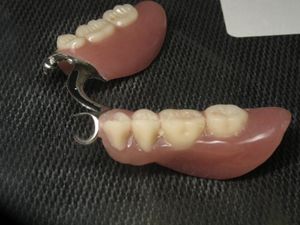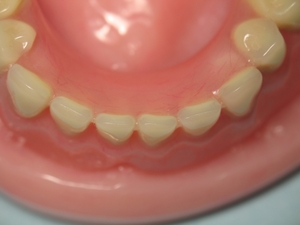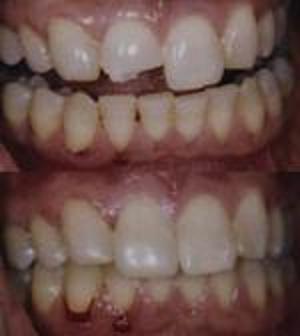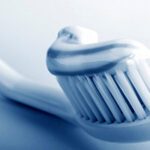People lose teeth for many reasons including accident, tooth decay and gum disease. Dentists offer a variety of techniques for replacing the missing teeth. Dentists help patients base their choice on comfort, cost, convenience and health. For cost and convenience, it is hard to beat removable partial dentures. The disadvantage of partial dentures is that they feel foreign and unnatural. They are a replacement body part that people learn to use much like a prosthetic arm or leg. Most people adapt well to a removable partial denture; some people do not.
Before replacing missing teeth, it is very important to ensure that the remaining teeth are healthy. Expect the dentist to carefully examine the teeth and gingiva (gums) visually and by x-ray. Teeth should not be replaced until the remaining teeth and gingiva are healthy.
Implant retained crowns are the state of the art for replacing missing teeth. Implant retained crowns will feel the most like natural teeth. Fixed bridgework utilizes crowns on remaining natural teeth to replace missing teeth with artificial teeth. Implant retained crowns and fixed bridges look and feel similar to natural teeth, but the cost may be out of the reach of many. It may cost about the same to replace a single tooth with an implant retained crown as it costs to replace several missing teeth with a removable partial denture.
Time is a consideration when replacing missing teeth. Although it may be possible to replace teeth with dental implants in a very short time, usually it takes months, even over a year. Partial denture treatment is normally complete in days to a few weeks.
It is possible to fabricate a partial denture to replace teeth that are not yet missing. Some dental offices are set up to provide this service over night or even in hours. For example, if teeth are loose due to periodontal disease, the dentist and the dental lab may fabricate a partial denture before removing the loose teeth. This is an immediate or interim partial denture. Interim partial dentures are usually made of a hard plastic material, acrylic. The partial may have wire clasps that hold onto two or more remaining teeth. As this type of partial is so quick and inexpensive, this is the partial denture of choice for many. A flipper is a acrylic partial denture that replaces a single tooth.
The most common partial denture is a highly technical piece of hardware that includes a cast metal framework, metal clasps that are carefully designed for individual teeth, pink acrylic to rebuild areas of gum tissue, and factory manufactured acrylic or porcelain teeth. Dentists carefully design these partials to stay in place, but dislodge with planned force in a particular path. The dentist must make adjustments to the natural teeth to accommodate their design of this kind of partial. Parts of the clasps fit into recesses in natural teeth or crowns.
Sometimes, the dentist instructs the lab to use special attachments. Complementary parts of precision attachments are formed into dental crowns or onto dental implants and the partial. Compare precision attachments to a metal coat snap. Advantages of precision attachments include the ability to make a partial denture that attaches without visible metal retainers, and the ability to adjust the force of retention easily. Building precision attachments as part of crowns reduces wear and force on the natural teeth. The only disadvantage of precision attachments is their cost. Depending on the brand or style of attachment, the cost for each attachment may be half that of the crown it is a part of.
Another alternative to standard metal clasps are clasps made of a tooth or gum colored plastic. Patients appreciate the smooth feel of the plastic clasp as it slides over the tooth when compared with the scraping feel of a tight metal clasp. These clasps appear to last nearly as long as those made of metal. The major disadvantage of plastic clasps is that they must be larger than those made of metal.
Another kind of partial denture is made of a flexible nylon material called Valplast or Flexite. Some patients appreciate the feel of partial dentures made of a resilient material. Flexible partial dentures move around with respect to the other teeth more than conventional partials. These partials depend more on the soft tissue for support. Expect to pay a premium for this kind of partial denture.
Flexible partial dentures are difficult or impossible to repair. Acrylic partials are relatively easy to repair. When another natural tooth is lost, it is likely that the dental lab technician is able to add a replacement on to an acrylic interim or conventional acrylic and metal partial.
There are a few important considerations when leaving the dental office with a new partial denture. Expect that the partial will feel funny. This is a sizable object. Its presence may cause increasing salivation during the adjustment period. The tongue and lips must become accustomed to using this device to form words and to chew food.
Learn to speak with the new partial by practicing. Try reading the newspaper out loud to a large mirror. Try not to dwell on the sound at first. People naturally adjust to new feel of the teeth, metal and pink acrylic. There may be some change in speech at first; speech may even improve with properly positioned, rebuilt teeth.
Eat soft foods at first. Noodles, soup, tofu, and bananas are good foods to begin with. Later, add small pieces of firm, chewy and crunchy foods. Do not expect to eat large bites of sandwiches and steak with partial dentures. Never use the plastic front teeth of dentures to tear or bite into foods. Front denture teeth are weak bits of plastic that will tend to come loose under pressure. Instead, tear off pieces of a sandwich or pizza and chew it will back or side teeth.
Careful design and systematic care of partial dentures will support and extend the life of associated natural teeth. That care must include impeccable hygiene (brushing and flossing), regular professional care, and adjustment of the partial as the teeth and gums change over time. Leave partials soaking in a container of water at night; dry acrylic may warp or crack.
Finally, ask your dentist to help determine which kind of partial denture is the best for you.








